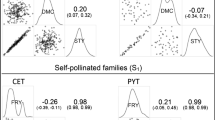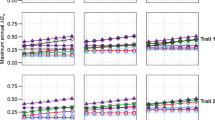Abstract
Selection index updating, a method of multistage selection, allows breeders to determine the optimal truncation point of each stage so that the aggregate genetic gain (▵H) or the gain to cost ratio (▵H/C) is maximum. In this study, we demonstrated the use of selection index updating on selection of red clover (Trifolium pratense L.). We determined the optimal selection schemes that optimized the balance between cost saving and lowered genetic gain in multistage selection. A total of 78 red clover half-sib families were evaluated for petiole length (PL), seedling vigor (Vig) measured at the seedling stage, and canopy height and individual plant dry weight recorded on initial growth (CH1 and DW1) and regrowth (CH2 and DW2). Alternative selection schemes with different number of stages, traits, and proportions selected at various stages were examined to maximize either ▵H or ▵H/C. Single stage index selection had a greater predicted genetic gain than multistage selection, but it was also associated with higher costs. Early culling at the seedling stage resulted in significant cost savings and increased gain to cost ratio. The ratio was 9.857 or more with early culling and 3.062 or less without seedling selection. The most efficient selection programs consisted of PL, Vig, DW1, and DW2. Inclusion of CH1 and CH2 into the selection indices did not contribute to the increase of the total genetic gain, nor to the increase of the ratio.
Similar content being viewed by others
References
Baker, R.J., 1986. Selection Index in Plant Breeding. CRC Press, Boca Raton, FL.
Bartels, V.S., E. Bruns & P. Glodek, 1980. Anwendungsmöglichkeiten der Mehrstufenselettion bei der Züchtung von Göttinger Miniaturschweinen. Z Tiers Züchtungsbiol 97: 101–115.
Bowley, S.R., N.L. Taylor & P.L. Cornelius, 1984. Phenotypic recurrent selection for stem length in ‘Kenstar’ red clover. Crop Sci 24: 578–582.
Bowley, S.R., C.T. Dougherty, N.L. Taylor & P.L. Cornelius, 1988. Comparison of yield components of red clover and alfalfa. Can J Plant Sci 68: 103–114.
Cochran, W.G., 1951. Improvement by means of selection. In: J. Neyman (Ed.), Proc 2nd Berkeley Symp Math Stat Prob, pp. 449–470. University of California, Berkeley, CA. USA.
Cunningham, E.P., 1975. Multi-stage index selection. Theor Appl Genet 46: 55–61.
Godshalk, E.B., D.H. Timothy & J.C. Burns, 1988. Application of multistage selection indices to crop improvement. Crop Sci 28: 23–26.
Hadley, G., 1964. Nonlinear and Dynamic Programming. Addison-Wesley Publishing, Reading, MA.
Hazel, L.N., 1943. The genetic basis for constructing selection indexes. Genetics 28: 476–490.
Hazel, L.N. & J.L. Lush, 1942. The efficiency of three methods of selection. J Hered 33: 393–399.
Kempthorne, O. & A.W. Nordskog, 1959. Restricted selection indices. Biometrics 15: 10–19.
Namkoong, G., 1970. Optimal allocation of selection intensity in two stages of truncation selections. Biometrics 26: 465–476.
Nguyen, N.T. & D.A. Sleper, 1983. Theory and application of half-sib matings in forage grass breeding. Theor Appl Genet 64: 187–196.
Pešek, J. & R.J. Baker, 1969. Desired improvement in relation to selection indices. Can J Plant Sci 49: 803–804.
SAS, 1985. SAS/IML User's Guide (Version 5 Ed). SAS Inst Inc Cary, NC.
Saxton, A.M., 1983. A comparison of exact and sequential methods in multi-stage index selection. Theor Appl Genet 66: 23–28.
Smith, H.F., 1936. A discriminant function for plant selection. Ann Eugen 7: 240–250.
Tai, G.C.C., 1976. Index selection with desired gains. Crop Sci 17: 182–183.
Tallis, G.M., 1962. A selection index for optimum genotype. Biometrics 18: 120–122.
Taylor, N.L., R.G. May, A.M. Decker, C.M. Rincker & C.S. Garrison, 1979. Genetic stability of ‘Kenland’ red clover during seed multiplication. Crop Sci 19: 429–434.
Wioncek, J., M. Krzaczek, K. Marcinek & T. Hulewicz, 1976. Phenotypic correlations within some characters of mother plants and their offspring in red clover (Trifolium pratense L.). I. Studies on diploid. Genet Pol 17: 171–179.
Xie, C. & J.A. Mosjidis, 1995. Seedling-selection effects on morphological traits of mature plants in red clover. Theor Appl Genet 91: 1032–1036.
Xu, S., 1993. INDUPDAT: A SAS/IML program for selection index updating. J Hered 84: 316.
Xu, S. & W.M. Muir, 1991. Multistage selection for genetic gain by orthogonal transformation. Genetics 129: 963–974.
Xu, S. & W.M. Muir, 1992. Selection index updating. Theor Appl Genet 83: 451–458.
Yamada, Y., K. Yokouchi & A. Nishida, 1975. Selection index when genetic gains of individual traits are of primary concern. Jap J Genet 50: 33–38.
Young, S.S.Y., 1961. A further examination of the relative efficiency of three methods of selection for genetic gains under less-restricted conditions. Genet Res 2: 106–121.
Young, S.S.Y., 1964. Multi-stage selection for genetic gain. Heredity 19: 131–145.
Young, S.S.Y. & H. Weiler, 1960. Selection for two correlated traits by independent culling levels. J Genet 57: 329–338.
Author information
Authors and Affiliations
Rights and permissions
About this article
Cite this article
Xie, C., Xu, S. & Mosjidis, J. Multistage selection indices for maximum genetic gain and economic efficiency in red clover. Euphytica 98, 75–82 (1997). https://doi.org/10.1023/A:1003074814916
Issue Date:
DOI: https://doi.org/10.1023/A:1003074814916




